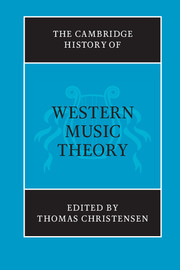Book contents
- Frontmatter
- Introduction
- PART I DISCIPLINING MUSIC THEORY
- PART II SPECULATIVE TRADITIONS
- 4 Greek music theory
- 5 The transmission of ancient music theory into the Middle Ages
- 6 Medieval canonics
- 7 Tuning and temperament
- 8 The role of harmonics in the scientific revolution
- 9 From acoustics to Tonpsychologie
- 10 Music theory and mathematics
- PART III REGULATIVE TRADITIONS
- PART IV DESCRIPTIVE TRADITIONS
- Index of authors
- Index of subjects
- References
6 - Medieval canonics
from PART II - SPECULATIVE TRADITIONS
Published online by Cambridge University Press: 28 March 2008
- Frontmatter
- Introduction
- PART I DISCIPLINING MUSIC THEORY
- PART II SPECULATIVE TRADITIONS
- 4 Greek music theory
- 5 The transmission of ancient music theory into the Middle Ages
- 6 Medieval canonics
- 7 Tuning and temperament
- 8 The role of harmonics in the scientific revolution
- 9 From acoustics to Tonpsychologie
- 10 Music theory and mathematics
- PART III REGULATIVE TRADITIONS
- PART IV DESCRIPTIVE TRADITIONS
- Index of authors
- Index of subjects
- References
Summary
The “canon” is the monochord, a single-stringed instrument suited for the production of musical pitches and the comparative measurement of the lengths of the string segments that produce them. In Plate 6.1, from Lodovico Fogliano’s Musica theorica of 1529, the monochordist has placed two movable bridges “about three fingers apart” at points marked A and B (the letters do not indicate the names of pitches, but designate points as in a geometric diagram); he has marked equal segments AC, CD, DE, EF, and BG, and placed bridges under points F and G. By moving the bridge he holds in his right hand, the monochordist can demonstrate that string segment DF, twice the length of BG, produces a pitch an octave (diapason) below that of BG; that CF, three times the length of BG, produces a pitch a twelfth (diapasondiapente) below that of BG; that AF, four times the length of BG, produces a pitch two octaves (bisdiapason) below that of BG.
In a systematic division of the monochord, a musician defines a number of pitches successively, at each step specifying the ratio between the length of the string segment that produces one pitch and that of the string segment that produces some other. The end results of such a monochord division are an array of pitches (which can be arranged in a scale) and a set of intervallic relationships between them specifically defined by numeric ratios (a tuning system). Canonics is the study of such pitch arrays and intervals and the ratios through which they are defined.
- Type
- Chapter
- Information
- The Cambridge History of Western Music Theory , pp. 168 - 192Publisher: Cambridge University PressPrint publication year: 2002
References
- 1
- Cited by

